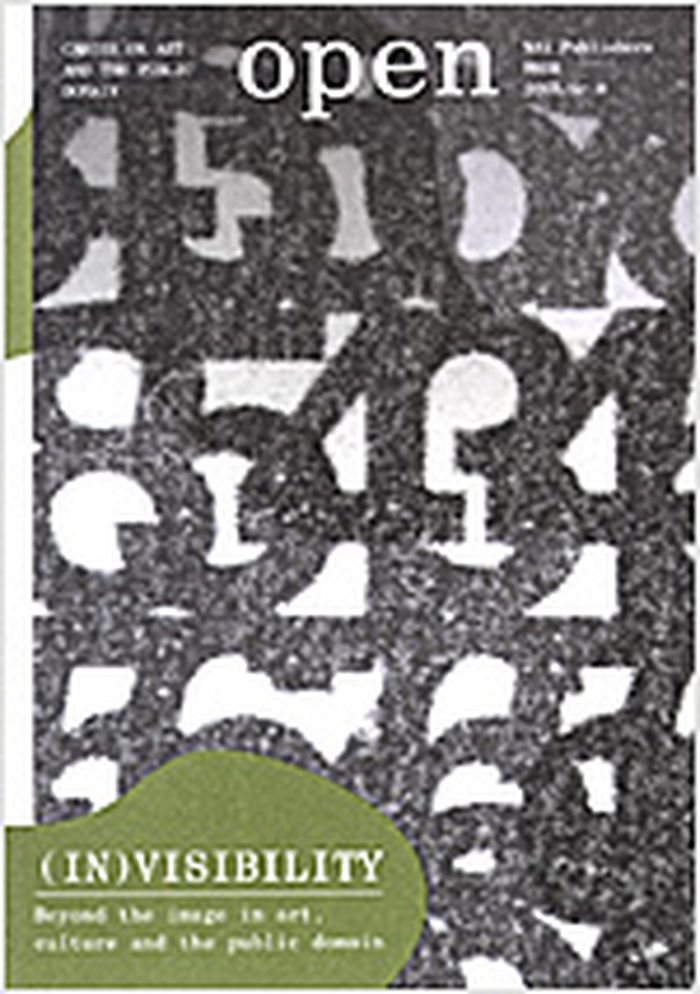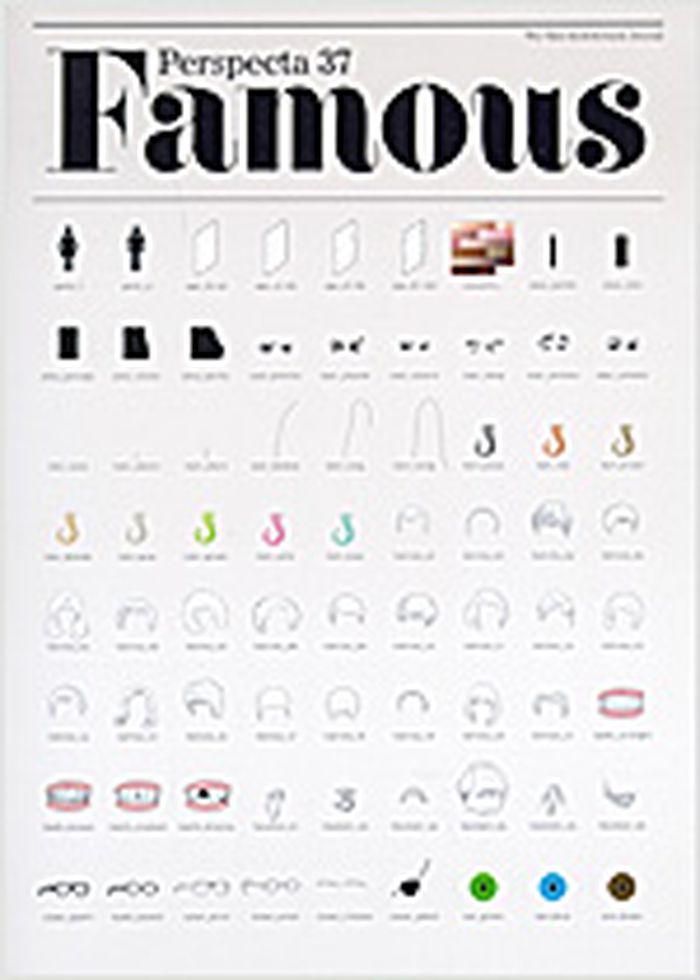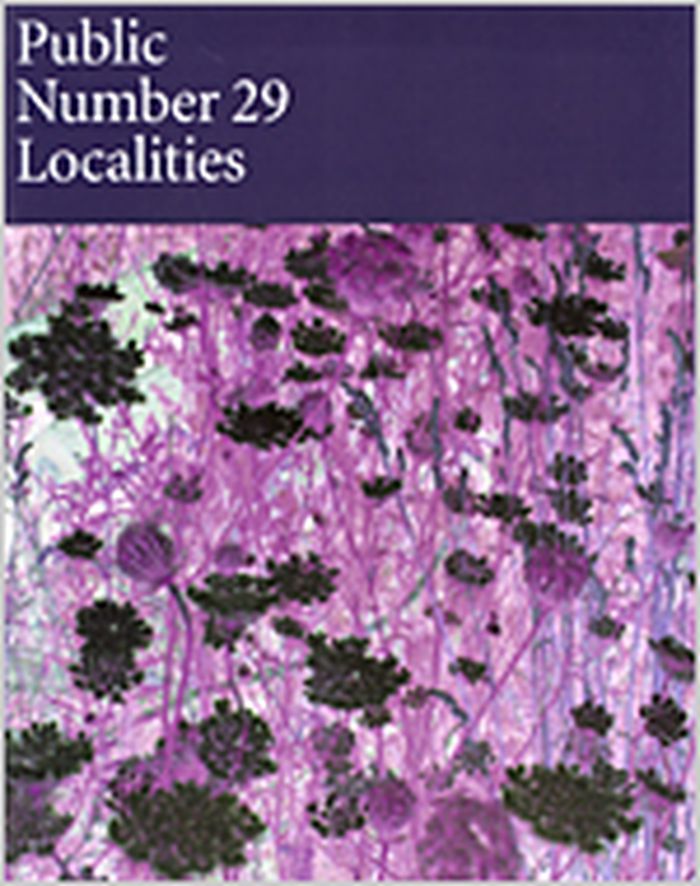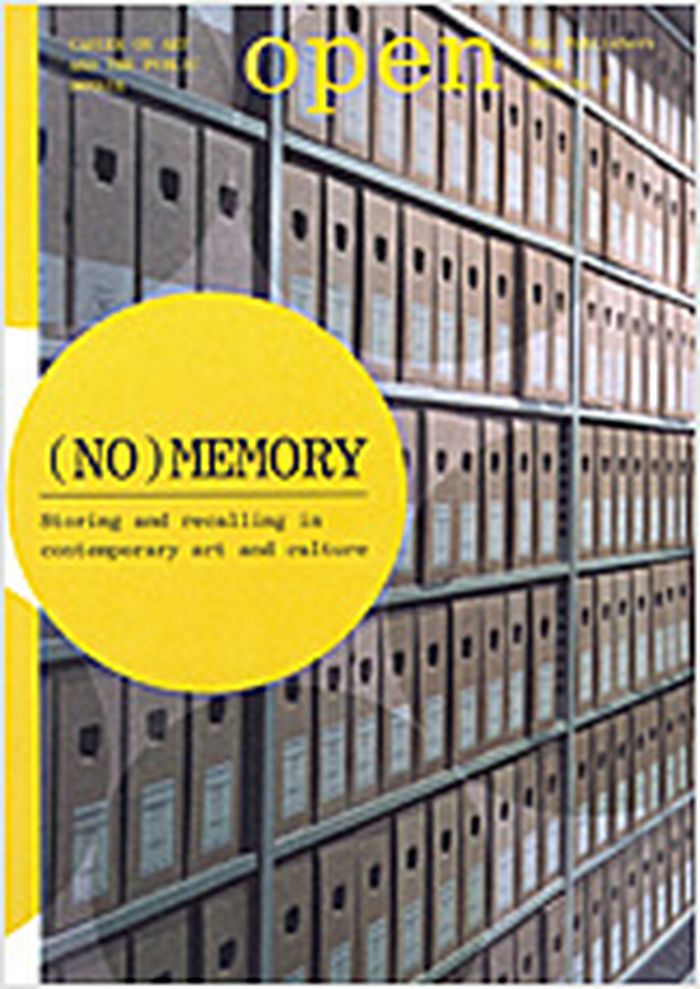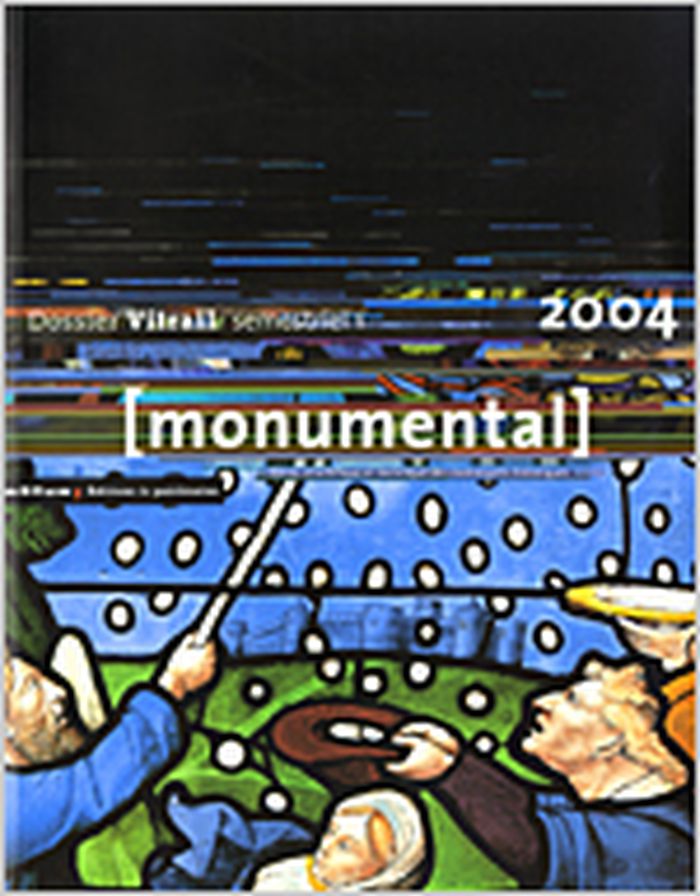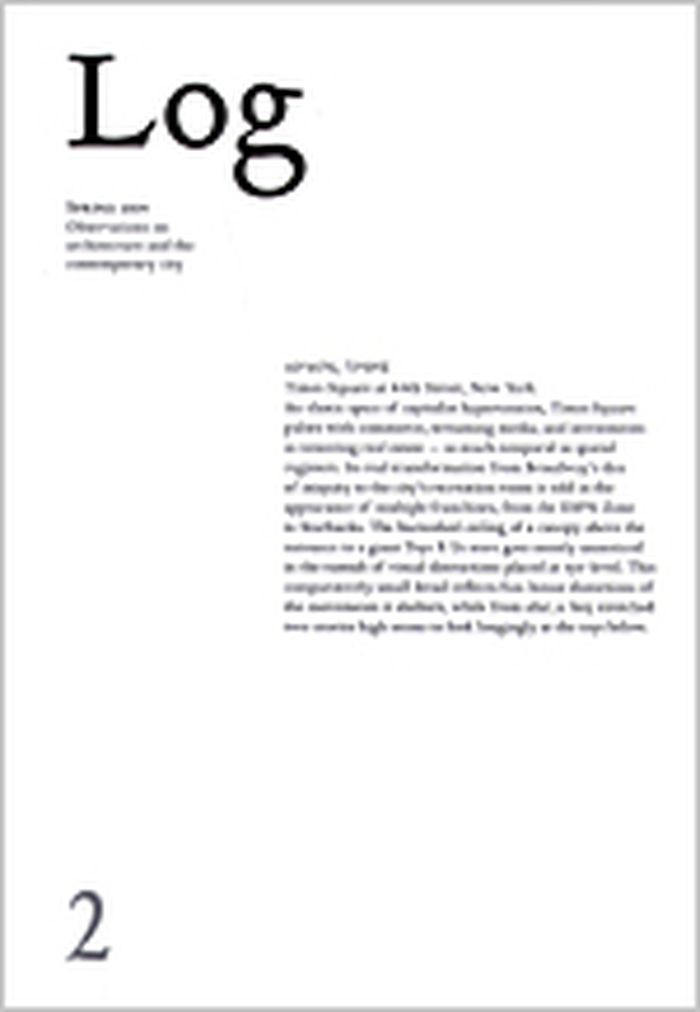$36.00
(disponible sur commande)
Résumé:
In our culture, in which the media play a predominant role, there is an increasing emphasis on achieving visibility and transparency. Openness and communication are subservient to that visibility, and even seem to coincide with it more and more emphatically. At the same time, both notions form the foundations for social order and political power. In our over-visualized(...)
Open 8 : (in)visibility : beyond the image in art, culture and the public domain
Actions:
Prix:
$36.00
(disponible sur commande)
Résumé:
In our culture, in which the media play a predominant role, there is an increasing emphasis on achieving visibility and transparency. Openness and communication are subservient to that visibility, and even seem to coincide with it more and more emphatically. At the same time, both notions form the foundations for social order and political power. In our over-visualized culture, however, it seems as if every message or social agenda is being squeezed out in favour of styling, commerce and fashion. What position does art occupy in this, or what position should it occupy? In "Open" 8, guest editors Willem van Weelden and Jan van Grunsven write a general introduction, Brian Holmes explores (in)visibility as a tactic in art, and Jouke Kleerebezem asks who actually decides about (in)visibility in the public space; Camiel van Winkel writes over the visual deficit of contemporary culture; Dieter Lesage critically examines the proposals by OMA/AMO for a new iconography of Europe; Henk Oosterling investigates the FBI's prosecution of the Critical Art Ensemble; Jorinde Seijdel considers how media images are used as evidence for social and political events. "Open" 8 includes interviews with Arno van der Mark of DRFTWD, an Amsterdam-based multidisciplinary design bureau, and with the French research organization Bureau d'études, as well as an account of a roundtable discussion about a possible new legitimation for academic training in 'art and the public space'. The cahier also presents a column by the Belgian architect/author Wouter Davidts, photographic essays and book reviews.
Revues
périodiques
Open 6 (in)security
$36.00
(disponible sur commande)
Résumé:
There is a yearning for security in today's public domain. The individual and the community are increasingly demanding protection from and control over the space, themselves and others. A society of control is looming, but one lacking a clear idea about the nature and the origin of its underlying fears. This cahier examines the consequences of the current preoccupation(...)
Revues
août 2004, Rotterdam
Open 6 (in)security
Actions:
Prix:
$36.00
(disponible sur commande)
Résumé:
There is a yearning for security in today's public domain. The individual and the community are increasingly demanding protection from and control over the space, themselves and others. A society of control is looming, but one lacking a clear idea about the nature and the origin of its underlying fears. This cahier examines the consequences of the current preoccupation with security for the public space and the visual arts. What are the implications for the functioning of the public domain, for its arrangement, design and experience? And how does this influence the task and perception of art? From art, architecture, philosophy and politics come theoretical and practical scenarios, proposals and visions that expose something of today's security paradigm, advocate alternative (conceptual) models or offer insights into the current ethics and aesthetics of security. Gijs van Oenen subjects the 'new securityscape' to a critical analysis. Lieven De Cauter digs into the various strata of the new fear. Sean Snyder presents images from his Temporary Occupation project. Thomas Y. Levin looks at how artists deal with surveillance in the public space. Sven Lütticken reflects on the concept of a 'human park' in philosophy, art and media. Harm Tilman focuses on architecture in a society of control. Mark Wigley analyses the issue of security in relation to the World Trade Center buildings in New York. Hans Boutellier wishes art would apply the brakes to the security Utopia. Jouke Kleerebezem calls for vigilance in the information society. Willem van Weelden discusses the project in Kanaleneiland, Utrecht. Q.S. Serafijn shows multiple dimensions of the interactive D-Tower in Doetinchem. Mark Wigley dissects the abode of the Unabomber.
périodiques
août 2004, Rotterdam
Revues
Perspecta 37 : famous
$22.95
(disponible sur commande)
Résumé:
Does fame empower architecture or undermine it? Does the star power or cult status of an architect enhance the art or dilute it? This issue of Perspecta examines the inner workings of fame as it relates to architecture though media and culture. It looks at how the commodification of architecture affects the design process - whether fame emphasizes all the wrong aspects of(...)
Revues
juin 2005, Cambridge, Mass.
Perspecta 37 : famous
Actions:
Prix:
$22.95
(disponible sur commande)
Résumé:
Does fame empower architecture or undermine it? Does the star power or cult status of an architect enhance the art or dilute it? This issue of Perspecta examines the inner workings of fame as it relates to architecture though media and culture. It looks at how the commodification of architecture affects the design process - whether fame emphasizes all the wrong aspects of architecture or provides the only way an architect can produce truly ambitious projects. How does architecture generate fame? And how does fame generate architecture? Celebrity permeates all levels of contemporary society; architecture, academia, the architectural press, and the mainstream media all play a role in promoting the mystique of the designer genius. The tradition of learning through apprenticeship and the struggle to have projects commissioned and built perpetuate the importance of the famous architect. Does this serve architecture or only the architectural star? The contributors to Perspecta examine both sides of the argument: Architecture moves forward through a process of innovation; fame provides the architect with the leverage needed to accomplish innovation. Or is it that fame, because of its relationship to the media and popular tastes, inevitably dilutes the quality of the architecture? Does "famous" architecture glorify only itself and neglect the people, the values, and the functions that it must serve?
Revues
périodiques
Exposé no 4 : la maison
$71.95
(disponible sur commande)
Résumé:
Ce numéro retrace une archéologie des multiples approches de la maison dans l'art contemporain des avant-gardes à nos jours. Il présente les travaux des architectes les plus avant-gardistes tout en retraçant de façon conceptuelle et ludique l’histoire et l'évolution du concept "d’habiter".
Exposé no 4 : la maison
Actions:
Prix:
$71.95
(disponible sur commande)
Résumé:
Ce numéro retrace une archéologie des multiples approches de la maison dans l'art contemporain des avant-gardes à nos jours. Il présente les travaux des architectes les plus avant-gardistes tout en retraçant de façon conceptuelle et ludique l’histoire et l'évolution du concept "d’habiter".
périodiques
octobre 2004, Orléans
Revues
Public 29 : localities
$20.00
(disponible sur commande)
Résumé:
This issue of "Public" approaches the concept of locality in a dialectical fashion - seeing in it new possibilities for translocalism, diverse coalitions, and critical engagements as well as new reactionary articulations of market fundamentalism and commodified difference.
Revues
janvier 1900, Toronto
Public 29 : localities
Actions:
Prix:
$20.00
(disponible sur commande)
Résumé:
This issue of "Public" approaches the concept of locality in a dialectical fashion - seeing in it new possibilities for translocalism, diverse coalitions, and critical engagements as well as new reactionary articulations of market fundamentalism and commodified difference.
Revues
$36.00
(disponible sur commande)
Résumé:
The modern design and perception of the public domain is to a large degree determined by the tension between different memories - individual and collective, old and new, indigenous and immigrant. This makes memory a topical theme in the public domain, and its content, management and place are in urgent need of renewed consideration. How can one actively make use of the(...)
Open 7 (no)memory : storing and recalling in contemporary art and culture
Actions:
Prix:
$36.00
(disponible sur commande)
Résumé:
The modern design and perception of the public domain is to a large degree determined by the tension between different memories - individual and collective, old and new, indigenous and immigrant. This makes memory a topical theme in the public domain, and its content, management and place are in urgent need of renewed consideration. How can one actively make use of the information that is stored in modern-day 'places of memory'? What role does art play in this? Is collective memory even a possibility these days? How can cultural heritage be made accessible without transforming city and countryside into one big open-air museum? And what are the implications of new media and digital storage technologies for the social and historical processes of preserving and remembering? Rudi Laermans analyses the modern-day 'heritage regime'. Frank van Vree examines the role of the contemporary monument. Cor Wagenaar advocates the introduction of time as an instrument for the Belvedere Policy. Wolfgang Ernst considers how the archive becomes a literal metaphor in a digital culture. Nico Bick photographed various archives. Jorinde Seijdel takes a closer look at the visual archive of Bill Gates. Sven Lütticken writes about the conspiracy of openness that is apparently at work in the mass media. Geert Lovink interviews artist and archivist Tjebbe van Tijen. Artists' contributions from Joke Robaard, Nico Dockx, Hans Aarsman, Arnoud Holleman and Barbara Visser. Other contributions by Henk Oosterling, Brigitte van der Sande, Stef Scagliola, Jordan Crandall and Paul Meurs.
Revues
$57.95
(disponible sur commande)
Résumé:
Dossier vitrail
Monumental, semestriel 1 : dossier vitrail
Actions:
Prix:
$57.95
(disponible sur commande)
Résumé:
Dossier vitrail
Revues
périodiques
$35.95
(disponible sur commande)
Résumé:
This issue of The Plan takes a kaleidoscopic tour around the world investigating the theme 'sustainable architecture'. Apartment buildings in Manhattan (Winka Dubbeldam), the Tamsa offices in Veracruz (Caruso & Torricella Architects), the Galway Institute of Technology (Murray O'Laoire Architects), the Shinkansen Station at Minamata (Makoto Sei Watanabe Architects) and(...)
Revues
juillet 2004, Bologna
The plan 006 : architecture and technologies in detail
Actions:
Prix:
$35.95
(disponible sur commande)
Résumé:
This issue of The Plan takes a kaleidoscopic tour around the world investigating the theme 'sustainable architecture'. Apartment buildings in Manhattan (Winka Dubbeldam), the Tamsa offices in Veracruz (Caruso & Torricella Architects), the Galway Institute of Technology (Murray O'Laoire Architects), the Shinkansen Station at Minamata (Makoto Sei Watanabe Architects) and many more. A frosted plastic cutting mat with ruler printed onto it is a free gift neatly tucked inside the front cover.
périodiques
juillet 2004, Bologna
Revues
$12.50
(disponible sur commande)
Résumé:
LOG is a new journal of writing about contemporary architecture, cities, and the built environment, published by the Anyone Project. A forum for observations, speculations and ideas about all things current, LOG examines the present with an architectural bent, an historical perspective, and a critical eye. It embodies its name; a log of events, a series of mono-logs(...)
Log 2, spring 2004 (observations on architecture and the contemporary city)
Actions:
Prix:
$12.50
(disponible sur commande)
Résumé:
LOG is a new journal of writing about contemporary architecture, cities, and the built environment, published by the Anyone Project. A forum for observations, speculations and ideas about all things current, LOG examines the present with an architectural bent, an historical perspective, and a critical eye. It embodies its name; a log of events, a series of mono-logs becoming a kind of dia-log; LOG is a reading of our spaces in and for our time.
Revues
périodiques
$39.95
(disponible sur commande)
Résumé:
The relationship between architecture and tourism has been the subject of ample research from the urban point of view, resulting in various theories about the "tourist gaze." Themes like identity and city branding are familiar to us all these days, but the relationship between architecture and the touristic landscape has thus far received much less consideration. Now that(...)
Revues
novembre 2004, Rotterdam
Oase 64 : landscape and mass tourism
Actions:
Prix:
$39.95
(disponible sur commande)
Résumé:
The relationship between architecture and tourism has been the subject of ample research from the urban point of view, resulting in various theories about the "tourist gaze." Themes like identity and city branding are familiar to us all these days, but the relationship between architecture and the touristic landscape has thus far received much less consideration. Now that tourism is occupying the natural landscape en masse, it is no longer possible to safeguard the ideal of pure, untouched nature. By its very definition, the touristic landscape is a construct in which cultural and functional aspects have a role. As far back as the 18th century, the experience of a touristic landscape was become a physical one; an irreversible transformation of the landscape has been the result. This edition of "OASE" focuses on architecture's contribution to the structuring of mass tourism in the context of landscape, on how architecture frames the landscape and regiments the flow of tourists. A variety of interventions and strategies are reviewed, from mega-structures and infrastructure in ski resorts and Mediterranean holiday villages to nostalgic settlements in man-made miniature landscapes.
périodiques
novembre 2004, Rotterdam
Revues
